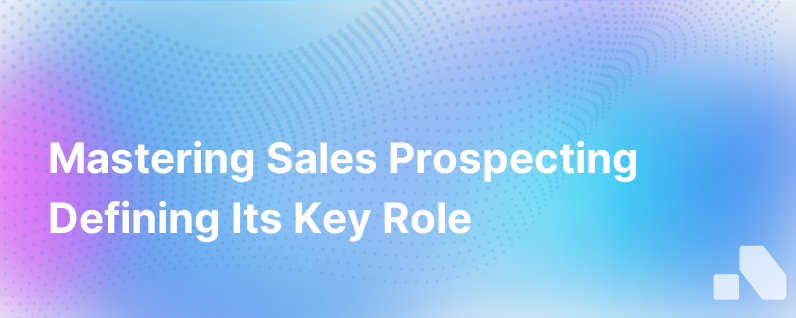
In the ever-evolving world of business, the term "sales prospecting" is synonymous with opportunity. It is a foundational process that fuels the sales funnel and is vital for any organization looking to maintain a competitive edge. Sales prospecting is the act of identifying potential customers, clients, or buyers for your products or services. It's not just about building a list of leads; it's about creating a pipeline of quality prospects who are more likely to convert into revenue-generating customers.
Understanding the subtle art of prospecting and why it is crucial can be the difference between a thriving business and one that fails to grow. This comprehensive guide delves into the definition, significance, and strategic importance of sales prospecting in a B2B context.
What is Sales Prospecting?
Simply put, sales prospecting is the process of sifting through the marketplace to find the right customers. It extends beyond basic lead generation to encompass the identification of potential customers, establishing initial contact, and nurturing those contacts with the aim to convert them into actual sales. It’s a proactive search for new business, and it involves several key actions:
- Researching potential market segments
- Identifying decision-makers within targeted businesses
- Reaching out to leads through personalized communication
- Building and fostering relationships
- Qualifying prospects according to predetermined criteria
The prospecting process can utilize a variety of channels, from networking events and referrals to cold calling, email marketing, and social selling. It's about leveraging every touchpoint to initiate conversations that position your offerings as solutions to customer problems.
Importance of Sales Prospecting in B2B Sales
Filling the Sales Pipeline
In the vast ocean of commerce, customers are the fish and prospecting is the net. Without a consistent flow of prospects, the pipeline dries up, and the chance to close new deals diminishes. Prospecting serves as an uninterrupted stream that keeps the sales pipeline filled with potential clients. This continuous flow is crucial for the sustainability of a business's revenue stream, providing ample opportunities to convert prospects into paying customers.
Anticipating and Adapting to Market Changes
Sales prospecting isn’t just about reaching out to potential buyers; it's also about staying attuned to market dynamics. A proactive approach to prospecting allows businesses to rapidly adapt to market changes, customer needs, and industry trends. This intelligence gathering is essential for tailoring product offerings to meet the evolving demands of the market.
Enhancing Revenue Streams
More prospects mean more opportunities for conversion, which translates to increased potential revenue. Strategic prospecting can identify up-sell and cross-sell opportunities, helping to expand your reach within existing customer accounts and increasing the overall customer lifetime value.
Conserving Time and Resources
Not all prospects are created equal. Effective prospecting focuses on quality over quantity, ensuring that sales teams spend their energy on leads that are more likely to convert. By targeting high-potential prospects, businesses conserve time and resources, applying their efforts where they are most likely to achieve results.
Building a Foundation for Lasting Customer Relationships
First impressions count and nowhere is this more true than in sales prospecting. This initial phase sets the tone for future interactions. By engaging prospects with relevance and providing value from the outset, sales professionals set the stage for building trust and maintaining long-term relationships.
Strategic Approach to Sales Prospecting
Defining the Ideal Customer Profile (ICP)
The first step in any successful prospecting strategy is to define what an ideal customer looks like for your business. Who benefits most from your product or service? What challenges do they face that your offerings can solve? Understanding these key elements helps focus prospecting efforts on the most viable potential clients.
Utilizing the Right Tools and Technology
Technology has revolutionized the way sales teams prospect. CRM platforms, social media, data analytics, and AI-driven tools like Aomni enhance efficiency and provide deep insights into prospective buyers. These tools help in segmenting data, personalizing outreach, handling repetitive tasks, and keeping track of interactions.
Constant Learning and Refinement
The best prospectors are always learning. They analyze past wins and losses, gather feedback, and refine their approach. Every interaction with a prospect is an opportunity to improve techniques and strategies.
Tailored Communication and Personalization
In the age of information overload, customization is key. Properly-executed prospecting involves crafting tailored messages that resonate with the specific needs and interests of potential clients. Personalized communication stands out, builds rapport, and demonstrates a commitment to delivering genuine value.
Conclusion
Sales prospecting isn’t just a task on a to-do list; it is the heartbeat of any successful sales operation. It requires diligence, precision, tenacity, and, above all, a strategic mindset. By recognizing its importance and continuously honing the craft, sales professionals can uncover golden opportunities that ensure the enduring growth and prosperity of their organizations.
Harnessing the power of modern tools like Aomni can streamline and augment your sales prospecting efforts, empowering teams to reach the right prospects at the right time with the right message. With refined processes and a commitment to continuous learning and adaptation, sales prospecting becomes not just a means to an end, but a continual source of competitive advantage and business success.